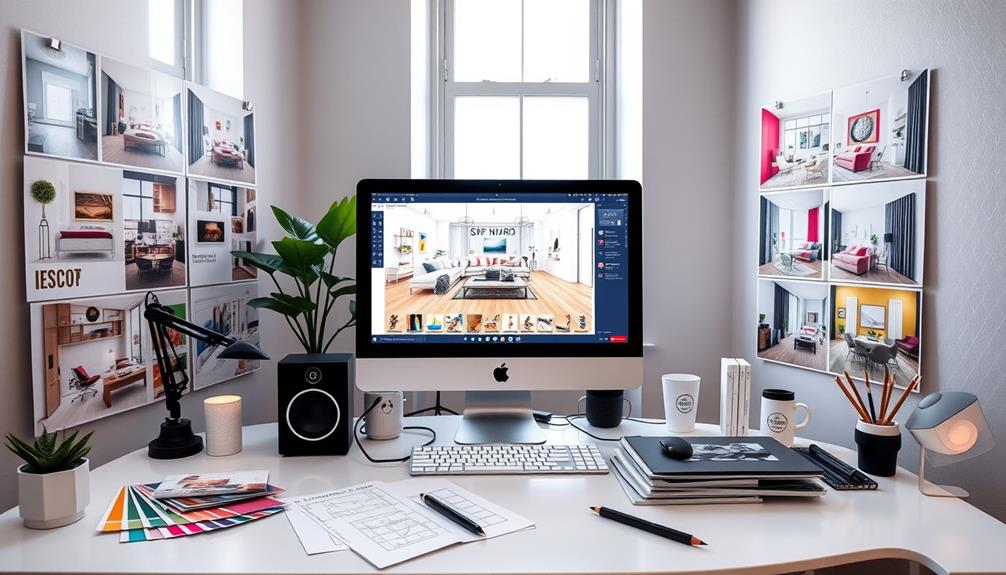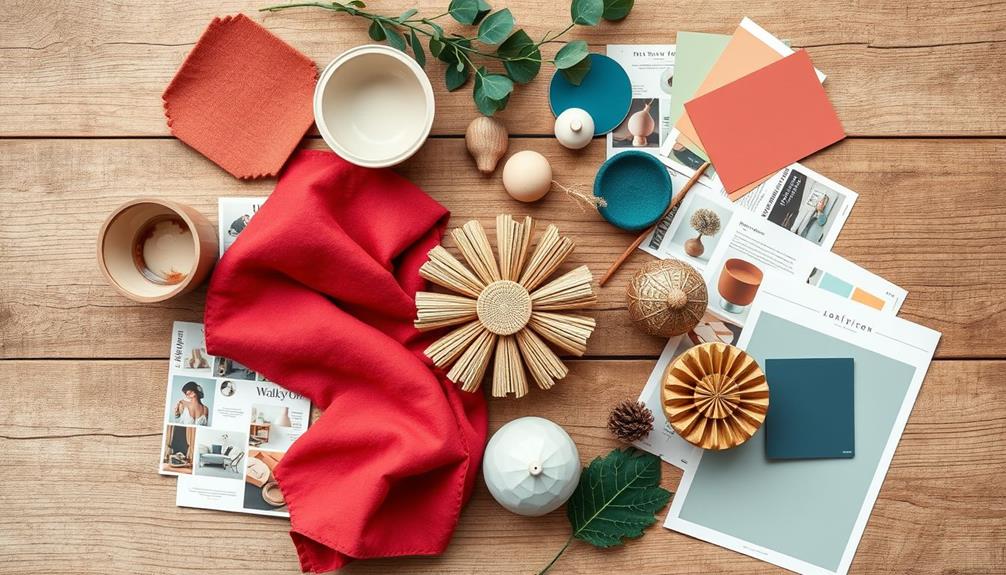To learn 3D interior design, start by familiarizing yourself with essential software like SketchUp, AutoCAD, and 3ds Max. Each tool has unique features suited for different design needs, so choose what fits you best. Engage in hands-on projects to solidify your skills, and seek out online courses or YouTube tutorials for guided learning. Joining design communities can spark creativity and offer valuable feedback. Consider accredited programs for a structured education path. Stay updated on design trends through magazines and podcasts. By exploring these avenues, you'll uncover even more tips and techniques to enhance your interior design journey. Once you have a good grasp of essential software and have honed your skills through hands-on projects and guided learning, it’s important to understand interior design basics like color theory, space planning, and furniture arrangement. These fundamentals will serve as a strong foundation for your 3D interior design work and will allow you to create cohesive and functional spaces. As you continue to learn and grow in your craft, always keep the interior design basics in mind to ensure your designs are both visually appealing and practical. Once you have a strong understanding of interior design basics, you can further enhance your skills by exploring advanced interior design software. Programs like Revit and Rhino can take your 3D interior design to the next level with their advanced modeling and rendering capabilities. By incorporating these tools into your design process, you’ll be able to create more intricate and realistic interior spaces. Remember to continue practicing and experimenting with different software to continuously improve and evolve your 3D interior design skills.
Key Takeaways
- Familiarize yourself with essential 3D design software like SketchUp, AutoCAD, and 3ds Max to enhance your modeling skills.
- Engage in hands-on projects to apply design tools and techniques, solidifying your understanding of 3D interior design.
- Participate in online design communities and forums to share ideas, receive feedback, and foster collaboration with peers.
- Utilize online learning platforms and tutorials to master software and stay updated with current design trends.
- Consider enrolling in accredited educational programs to gain a solid foundation in interior design principles and practical experience.
Understanding 3D Interior Design
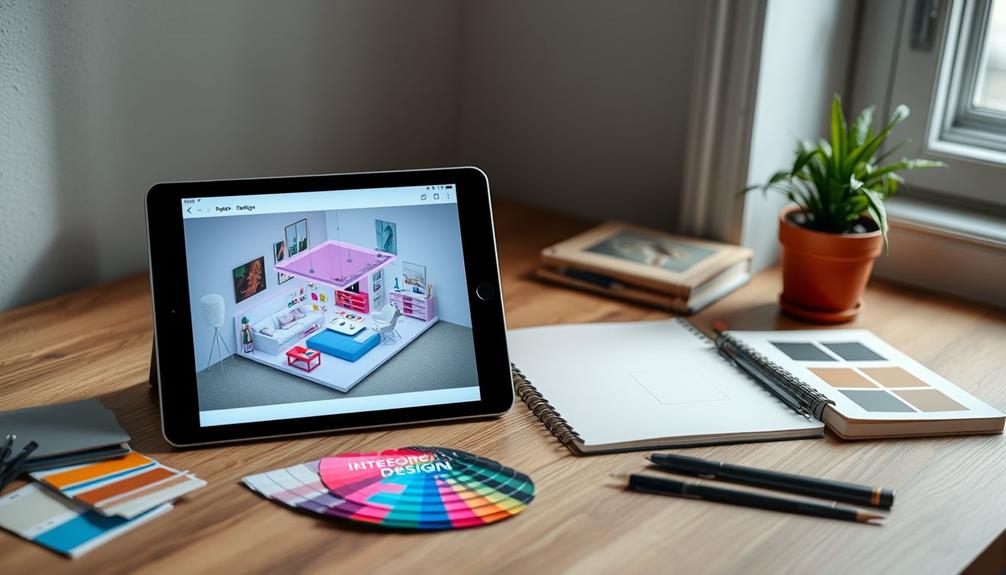
3D interior design is all about creating detailed, three-dimensional models of building interiors that include everything from structural elements like walls and windows to furniture and decor. This approach allows you to produce realistic 3D models that offer clear visualization of your design concepts.
By using modeling software, you can streamline the design process, making it easier to create presentations for stakeholders.
To enhance communication, 3D interior design helps clients and stakeholders visualize layouts and intentions without relying solely on verbal descriptions. It's important to choose the right tools for the job; software like Blender, 3ds Max, and SketchUp are essential for effective modeling.
Rendering engines such as V-Ray and Corona Renderer are critical for producing high-quality visual outputs that bring your designs to life.
Additionally, incorporating 3D scanning technology allows you to capture existing spaces with precision, which can further enhance customization options. You can even create interactive walkthrough tours, providing an immersive experience that showcases your designs in a dynamic way.
Essential Software Tools
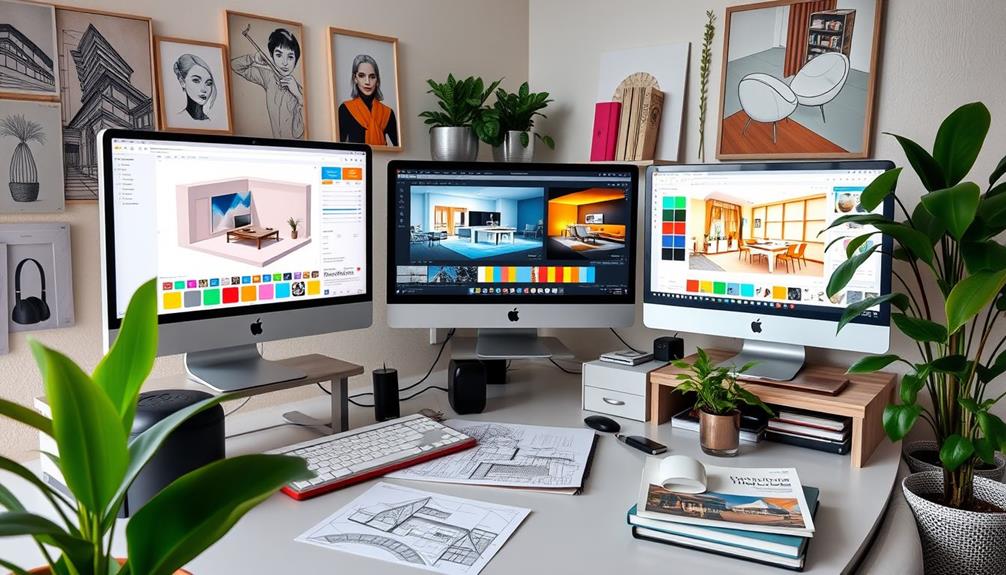
To master 3D interior design, you'll need to get familiar with popular design software.
Each tool offers unique features that can enhance your projects, so it's important to compare them and find what suits your style best.
Plus, there are plenty of learning resources available to help you get started and improve your skills.
Popular Design Software
When diving into the world of interior design, selecting the right software tools is essential for bringing your creative visions to life. Here are some popular design software options that can elevate your interior design projects:
- SketchUp: Known for its user-friendly interface, it's perfect for both beginners and pros, making 3D modeling easy and versatile. Additionally, using high-quality headphone amplifiers can enhance your listening experience while working on detailed designs.
- AutoCAD: This industry-standard software is indispensable for drafting precise 2D and 3D drawings, vital for creating accurate floor plans.
- Revit: As a Building Information Modeling (BIM) tool, Revit enables you to integrate architectural elements seamlessly into your designs, enhancing detail and documentation.
- 3ds Max: Ideal for generating photorealistic visuals, 3ds Max is powerful for 3D modeling and rendering intricate designs that truly stand out.
Additionally, Blender offers an open-source solution to explore advanced design techniques without breaking the bank. Its extensive capabilities cover everything from modeling to animation, making it a valuable asset for any aspiring designer.
Key Features Comparison
Choosing the right software is just the beginning; understanding their key features can greatly enhance your interior design projects. Each tool offers unique capabilities tailored to various aspects of the design process.
Here's a comparison of essential software tools for 3D interior design:
| Software | Key Features | Best For |
|---|---|---|
| SketchUp | User-friendly, extensive Pro features | Beginners & Professionals |
| 3ds Max | Advanced modeling, meshing, texturing | Photorealistic detail |
| Chief Architect | Intuitive design, automated documentation | Streamlined design process |
SketchUp is perfect if you're starting out, thanks to its ease of use. For those seeking photorealistic detail, 3ds Max is your go-to, offering complex modeling services. Chief Architect automates vital documentation, making it ideal for efficient project management. Don't forget to pair your modeling software with V-Ray, which enhances your designs with stunning rendering capabilities, bringing your interior designs to life. By understanding these key features, you can select the right software to elevate your 3D interior design projects.
Learning Resources Availability
In today's digital age, finding quality learning resources for essential 3D interior design software is easier than ever. With a variety of powerful tools available, you can elevate your design skills and bring your creative visions to life.
Here are some of the top software tools you should consider:
- SketchUp: Its user-friendly interface makes it a favorite among beginners and pros alike.
- AutoCAD: Known for its precision, it's perfect for creating detailed architectural drawings.
- Blender: A free, open-source option that offers extensive modeling and rendering capabilities.
- Chief Architect: This BIM software streamlines the design process with its intuitive environment.
For rendering, consider using V-Ray or Corona Renderer to enhance the quality of your visuals.
These tools allow you to create photorealistic representations, showcasing your designs in the best light.
Whether you're just starting or looking to refine your skills, leveraging these software tools and the associated learning resources will help you master 3D interior design and make your ideas come alive.
Don't hesitate to plunge into and explore the exciting world of modeling!
Key Learning Resources

A variety of key learning resources can help you master 3D interior design effectively. Start by utilizing online platforms like Coursera and Udemy, which offer extensive courses that include practical assignments and projects for hands-on experience. These courses often cover various aspects of 3D interior design, from basic concepts to advanced techniques.
YouTube channels dedicated to interior design tutorials provide step-by-step guidance and inspiration, making it easier for you to grasp essential design skills. Engaging with podcasts can also broaden your understanding of the field, as they discuss trends, techniques, and insights related to interior design.
Don't forget to access blogs and websites that feature case studies and design tips, offering you valuable knowledge on current practices and innovative ideas in 3D design.
Familiarize yourself with top software tools like SketchUp, AutoCAD, and Revit; these are essential for creating professional-grade interior designs. By leveraging these learning resources, you'll build a strong foundation in 3D interior design, preparing you for more advanced skills and techniques in the future. Mastering these tools not only enhances your design efficiency but also allows you to bring your creative visions to life with precision and accuracy. Specifically, using AutoCAD for interior design enables you to develop detailed floor plans and layouts tailored to client needs, ensuring a functional and aesthetically pleasing space. As you gain experience, you’ll find it easier to integrate these tools into complex projects, giving you a competitive edge in the industry.
Building Practical Skills
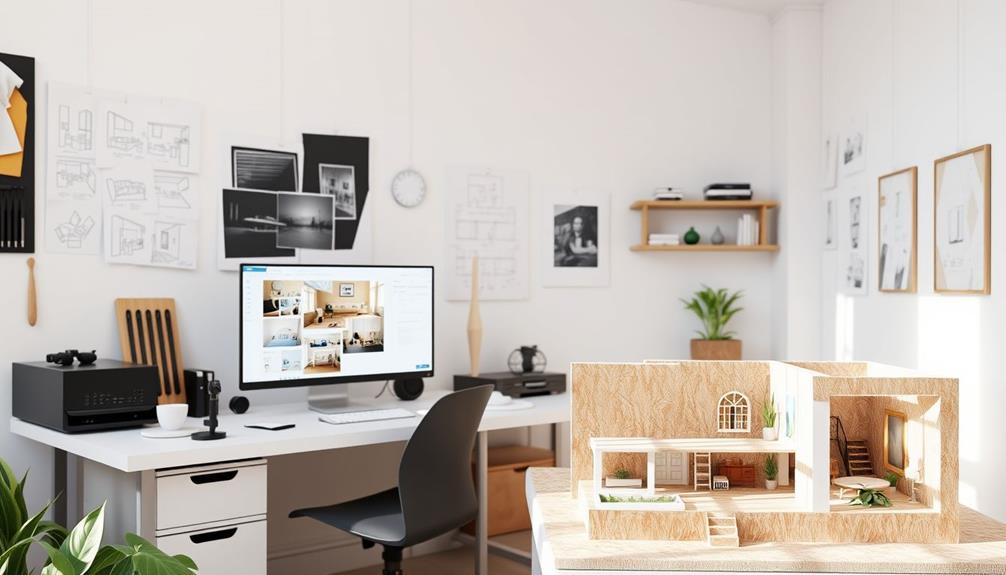
Mastering practical skills in 3D interior design involves actively engaging with hands-on projects and assignments. To solidify your understanding of design tools and techniques, immerse yourself in practical assignments included in extensive courses like those offered by M.P. Salaimanimagudam.
Utilize top design software such as SketchUp, AutoCAD, and Revit to create custom 3D designs tailored to various environments.
To enhance your experience, consider the following:
- Collaborate with peers to spark innovative ideas and approaches.
- Access online platforms for tutorials that keep you updated on current trends.
- Regularly seek feedback from instructors to refine your skills.
- Embrace networking opportunities to build valuable connections in the industry.
Engaging in peer-to-peer learning fosters collaboration and helps you explore new design concepts.
By actively participating in these practical assignments, you'll not only gain proficiency in design software but also develop a deeper understanding of effective design strategies.
Engaging With Design Communities

Building practical skills in 3D interior design naturally leads you to the vibrant world of design communities. Engaging with these communities, whether online or locally, provides you with invaluable opportunities to enhance your knowledge and creativity.
Joining forums or social media groups focused on 3D interior design allows you to connect with experienced designers, share your ideas, and receive constructive feedback on your work. Additionally, participating in tailored solutions for unique needs helps you gain insights into innovative design approaches, further enriching your skillset tailored solutions.
Participating in design competitions can greatly boost your skills while keeping you updated on industry trends. These competitions also offer excellent networking opportunities, helping you build connections within the design community.
Local meetups and workshops further foster collaboration and knowledge exchange, allowing you to learn from fellow designers and share your experiences.
Additionally, following influential designers and educators on platforms like Instagram and YouTube keeps the inspiration flowing, offering you tutorials and insights into the latest techniques and software.
Don't forget to showcase your personal projects on platforms like Behance and Dribbble. This not only promotes visibility but also invites critique and advice from a diverse community of design professionals, enhancing your growth in 3D interior design.
Exploring Educational Programs

As you immerse yourself in 3D interior design, exploring accredited educational programs can greatly enhance your skills and understanding of the field. Institutions like the New York School of Interior Design and Rhode Island School of Design (RISD) focus on both creative and technical skills essential for mastering this discipline.
With degree options such as Bachelor of Science (BS), Bachelor of Fine Arts (BFA), and Bachelor of Arts (BA), you can tailor your education to your interests.
Consider these aspects when choosing a program:
- Comprehensive coursework to strengthen your design foundation.
- Hands-on training in software tools like SketchUp and AutoCAD.
- Networking opportunities with industry professionals.
- Internship programs that provide real-world experience.
Online platforms also offer flexible courses in 3D interior design, allowing you to learn at your own pace.
Look for programs accredited by the Council for Interior Design Accreditation (CIDA) to guarantee that they meet industry standards.
Career Opportunities in Interior Design
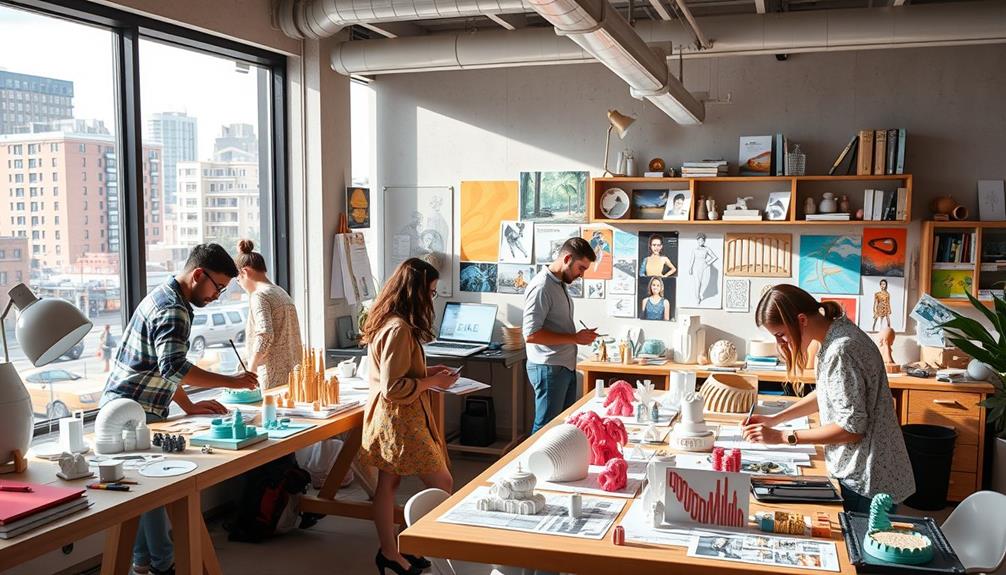
In today's rapidly evolving design landscape, career opportunities in interior design are abundant and diverse. The demand for skilled interior designers continues to grow, with top institutions like Pratt Institute and Rhode Island School of Design (RISD) reporting high job placement rates.
Additionally, the integration of methods like Design Thinking leadership fosters a culture of creativity, making candidates more appealing to employers. You'll find that practical experience gained through internships is essential, as it equips you with hands-on learning that enhances your employability in a competitive job market.
Networking and building industry connections are important for career advancement. These relationships often lead to job opportunities and collaborations that can greatly boost your career.
Continuous education is fundamental too; specializing in areas like sustainable design or 3D modeling can elevate your position and increase your earning potential.
Participating in design competitions is another excellent way to showcase your talent and innovative ideas. These events can translate into recognition and further career opportunities within the industry.
Staying Updated With Trends

Staying updated with trends is essential for any aspiring 3D interior designer. The design world evolves rapidly, and keeping your skills sharp can set you apart. Here are some effective ways to stay in the loop:
- Follow leading interior design magazines for the latest styles and materials.
- Listen to podcasts about interior design to hear from industry experts on emerging trends.
- Engage with social media platforms like Instagram and Pinterest for daily visual inspiration.
- Attend industry events and workshops to network and learn about new design philosophies.
Utilizing online courses will help you master the latest software updates and continuously improve your skills.
These resources not only provide valuable insights into the latest trends but also allow you to understand different design philosophies shaping the industry. By immersing yourself in these platforms, you'll cultivate a deeper appreciation for 3D interior design and its evolving nature.
Staying informed about emerging trends will enhance your creativity and adaptability, making you a more competitive designer.
Conclusion
In your journey to master 3D interior design, you'll blend creativity with technical skills, transforming spaces while expressing your unique vision. As you navigate the balance between artistry and precision, remember that every great designer once started as a beginner. Embrace the challenges you face, for they'll shape your expertise and style. Ultimately, it's not just about creating stunning interiors; it's about crafting experiences that resonate, turning mere rooms into reflections of life and personality.
